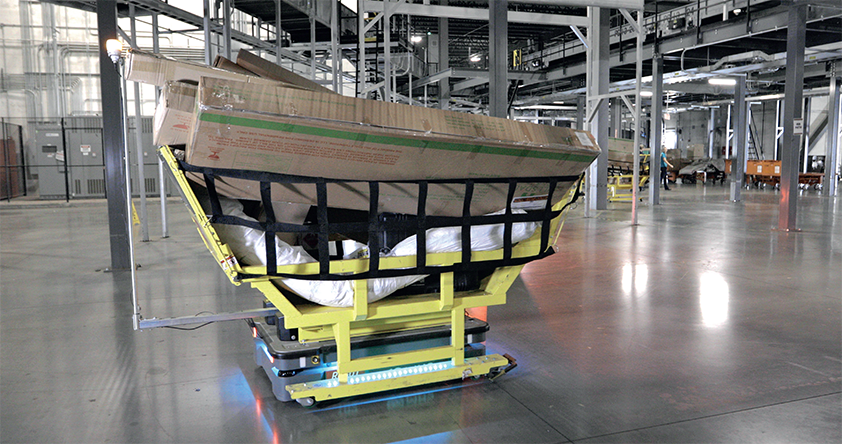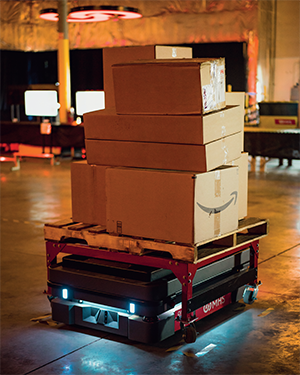
Incredible bulk
Good news! The new sofa you ordered arrived. Bad news – you have to move it to your living room. The flat-pack box is lean, but also long and wide – so much so, that it barely fits through the door from your carport into your house.
What you’re experiencing in the struggle of moving such a bulky, irregularly shaped item through your house is reminiscent of the challenges that distribution centers face handling such items every day.
These items are described as ‘non-conveyable’ when their physical characteristics prevent them from being handled by automated conveyor and sortation systems, necessitating alternative workflows.
Handling such items is not a new challenge. However, the expansion of direct-to-consumer models and e-commerce, which is expected to gross $5.55 trillion globally in 2022, has shifted who is responsible for moving such items and how frequently.
Businesses solely dedicated to online ordering and direct-to-consumer delivery of products like furniture and outdoor equipment are creating logistics operations wholly focused on handling large, irregular items. But the impact does not stop there – the downstream effect of greater non-conveyable volumes affects parcel carriers, too.
Labor challenges only compound the difficulty operations face, as they face more bulky items and have fewer employees to handle them.
Under these conditions, more businesses stand to benefit from alternative automation solutions designed to handle the growing segment of non-conveyable items.
 Disadvantages of manual handling
Disadvantages of manual handling
Transporting non-conveyable items manually, such as loading them onto carts, can ultimately lead to congestion and disorganization on the dock. It also uses a significant amount of labor and can require employees to manually lift and awkwardly twist in ways that can lead to repetitive stress injuries.
The U.S. Bureau of Labor Statistics reports nearly 150,000 back injuries per year in the workplace – and the business impact of each one adds up quickly. Direct costs attributed to medical and legal costs as well as OSHA fines can add up to thousands for each injury.
Costs aside, the transient nature and scarcity of labor makes it difficult to rely on manual processes. Turnover keeps getting higher in the warehousing industry, rising from just over 40 percent in 2016 to nearly 50 percent in 2021.
Evaluating workflows for automation
Investing in automation to handle non-conveyable items can bring a quick ROI and significant savings, including reduced labor dependency and risk of on-the-job injuries and related labor costs. Operations should take inventory of the share of non-conveyable items to be handled, identify all the workflows involved in the process and estimate the associated labor requirements.
The guiding principle is to automate the most mundane, repetitive parts of the process and leverage employees for tasks that require the unique capabilities of humans, like quality assurance inspection. For example, automate repetitive, point-to-point transportation with a low-cost autonomous mobile robot (AMR) solution that mitigates the risks associated with having employees maneuver loads through congested travel paths.
Customizing the automated solution
Because each operation is unique, an automated solution requires an inherent degree of customization. For example, a robotic arm may be necessary to load items onto an AMR.
Each type of non-conveyable item and warehouse environment presents its own unique challenges. Finding the right balance involves meeting requirements without overwhelming your operation with additional functionality that is both unnecessary and costly.
Trying the solution on for size
A pilot program offers an important step to get a solution for non-conveyables off the ground. It provides an opportunity to not just anticipate but answer key questions about AMRs, including those about throughput and scalability, before a full implementation. An added benefit of the AMR approach is flexibility. For example, operations can expand a traditional automated component like a sorter, but that requires taking it offline, removing and reinstalling infrastructure. In contrast, scaling capacity with more AMRs does not require shutting down the rest of the fleet.
Regardless of whether non-conveyables account for a facility’s core business or are simply a rapidly growing ‘necessary evil’, automating their handling requires a level of customization and expert help to find the right fit.
For a list of the sources used in this article, please contact the editor
Bruce Bleikamp is a director of product management at MHS. MHS is a leading global provider of material handling automation and software for distribution and fulfillment, parcel, e-commerce, manufacturing and other industries. The company’s turnkey approach takes care of all design, engineering and integration to deliver automated equipment, robotics, software and controls that work seamlessly according to customer requirements.
https://www.mhsglobal.com/